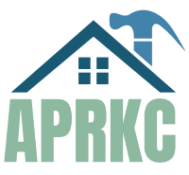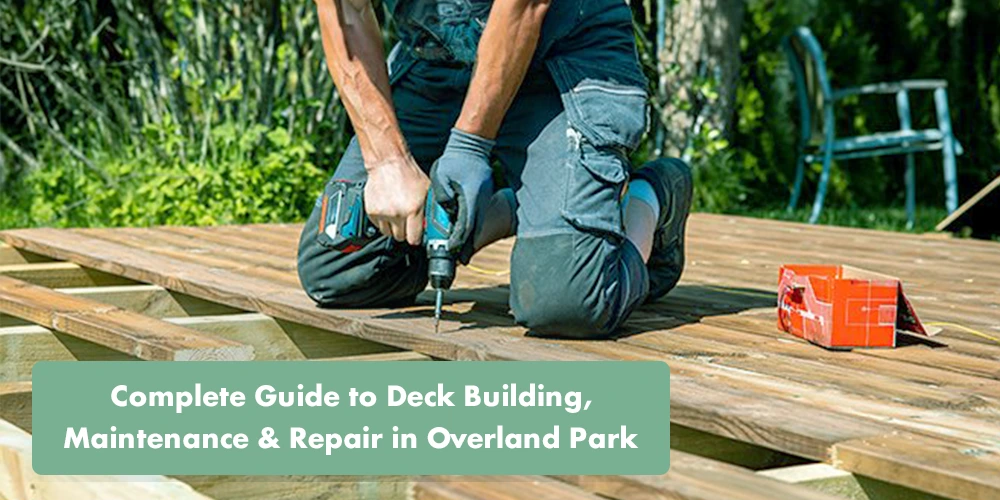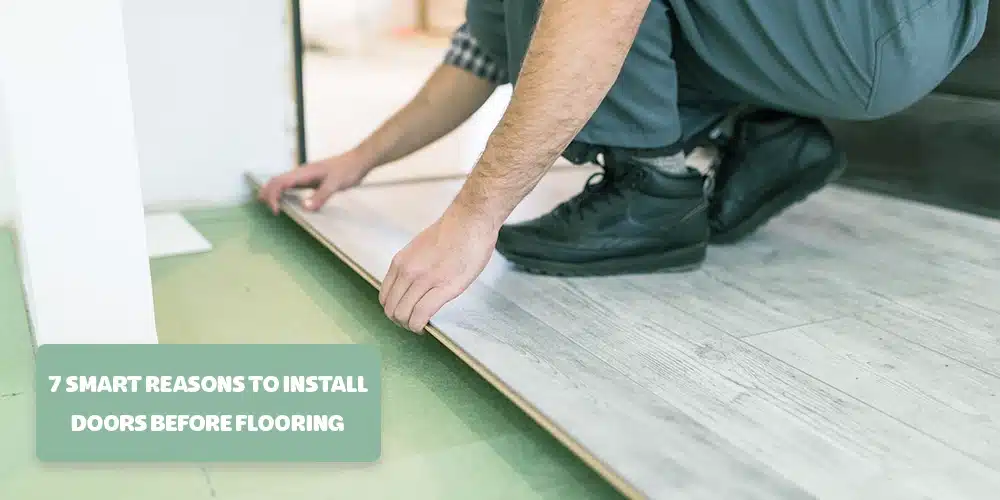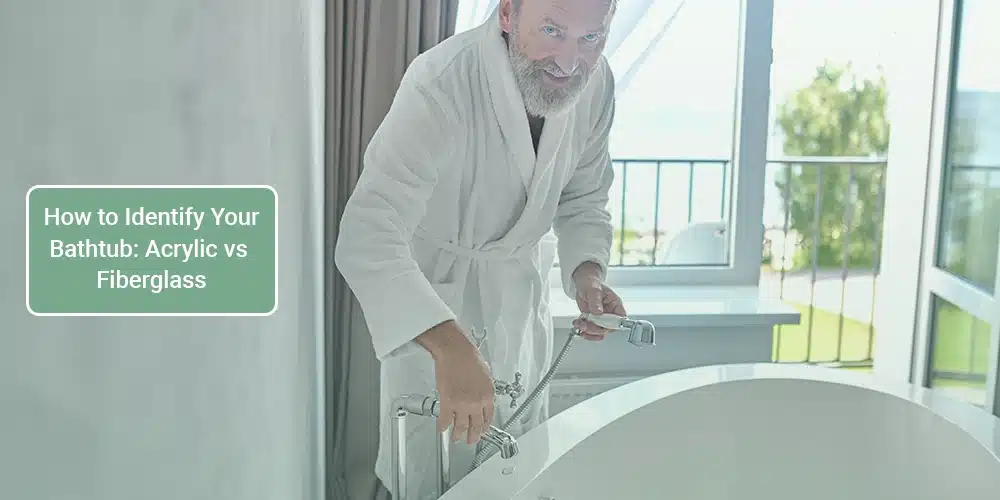Imagine stepping out onto a beautiful, functional deck – an extension of your home, perfect for relaxation or entertaining, right in your own backyard here in Overland Park.
A well-designed deck can elevate your home’s outdoor living space, creating a place to unwind and socialize with friends and family. However, planning, building, and maintaining a deck in Kansas’ climate comes with unique challenges that require careful consideration.
This comprehensive guide is designed to provide Overland Park homeowners with all the information they need to successfully plan, build, maintain, and repair a deck that will last for years to come.
From material choices and timing to essential maintenance and repair tips, this guide is your go-to resource for making informed decisions about your outdoor space.
Why a Deck for Your Overland Park Home?
Adding a deck to your Overland Park home brings a wide range of benefits, from increasing your living space to boosting your property value. Not only does it provide a functional outdoor area for everything from entertaining guests to enjoying some peaceful solitude, but it also works well with the unique climate in the Kansas City area.
Whether you’re looking to spend more time outdoors or make your home more appealing to potential buyers, a deck offers lasting value. Let’s break down the key reasons why building a deck is a smart decision for your home.
- Enhances outdoor living space: A deck extends your home’s usable space, creating a versatile area for relaxing, dining, or entertaining.
- Increases home value: Homes with well-maintained decks tend to sell for more, making it a solid investment if you ever decide to put your house on the market.
- Fits the Overland Park lifestyle: The local climate makes outdoor living highly enjoyable, and a deck provides a perfect spot to take advantage of Kansas’ warm summers and cooler months.
- Improves drainage: Elevated decks can help address drainage issues in your yard, keeping your outdoor space dry even after heavy rain or melting snow.
Deck vs. Patio: Making the Right Choice
When deciding between a deck or a patio for your Overland Park home, it’s important to understand how each option fits with the landscape of your yard and how you plan to use the space. Both have unique benefits, but the best choice depends on factors like the terrain, drainage, and your lifestyle.
Feature | Deck | Patio |
Terrain | Works well on sloped/uneven ground | Best for flat, level yards |
Materials | Wood, composite, PVC | Stone, concrete, pavers |
Drainage | Elevated, allows air flow | Needs careful planning to avoid pooling |
Customization | Highly customizable in height, size, and features | Limited to the shape and layout of the surface |
Maintenance | Requires ongoing upkeep (sealing, staining) | Generally lower maintenance, but depends on material used |
Cost | Can be more expensive (especially if raised) | Typically more affordable depending on materials |
Planning Your Overland Park Deck Project
Planning your deck project is an exciting but detailed process that requires careful thought and preparation. By taking the time to carefully plan, you ensure that your deck meets your needs, complies with local regulations, and stays within your budget. Here’s how to approach the planning phase:
Defining Your Needs and Vision
Before you get into the specifics, take a step back and think about what you want from your deck. Will it be an outdoor entertainment space for family gatherings? Or maybe a quiet spot for relaxation? The size, shape, and functionality of your deck will depend on how you plan to use it.
- Size: Consider how much space you need. If you’re entertaining guests often, you’ll want more space for seating and activities. If it’s a personal retreat, a smaller, cozier deck might be ideal.
- Shape: Do you want a traditional rectangular deck, or something with more curves? Your deck’s shape will impact both the design and material choices.
- Functionality: Think about how you’ll use the deck. Will you want built-in features like seating, a grill, or a fire pit? These features will need to be incorporated into the design from the very start.
Understanding Local Building Codes and Permits
Overland Park and Johnson County have specific building codes that you must follow when constructing a deck. These codes ensure safety and structural integrity. Understanding these regulations before you begin will save you time and prevent potential issues.
- Building Codes: Make sure you’re aware of local code requirements regarding deck size, height, materials, and structural safety.
- Permits: Most deck projects will require a permit, especially if it’s attached to your home or raised off the ground. The permit process ensures your deck complies with all regulations, including safety and structural standards.
___________________________________________________________________
Tip: Always check the current building codes and obtain the necessary permits from the Overland Park or Johnson County building department to avoid costly delays or fines.
___________________________________________________________________
Working with a Designer or Contractor
While you can design your deck yourself, working with a professional can make the process smoother, especially if you’re unfamiliar with local codes or construction practices. A designer or contractor can help you refine your vision and ensure everything is up to standard.
- Designer: A designer can create a layout that maximizes your available space while meeting both your aesthetic and functional needs.
- Contractor: Hiring a contractor is essential for executing the design. Choose someone with experience in deck construction who is familiar with local regulations. A good contractor will also handle the permitting process for you.
Budgeting for Your Deck Project
Once you have a clear vision, it’s time to budget. Decks can range in cost depending on size, materials, and features, so having a solid financial plan is key.
- Material Costs: The type of material you choose—wood, composite, or PVC—will significantly affect your budget. Wood is usually more affordable initially, but composite or PVC may save money in the long run due to lower maintenance costs.
- Labor Costs: If you’re hiring a contractor, their labor costs should be factored in, as well as any other services you may need, such as excavation or site preparation.
- Contingency Fund: Always set aside a small portion of your budget for unexpected costs—around 10-15% is a good rule of thumb.
Choosing the Right Deck Materials for Kansas Weather
When building a deck in Overland Park, the weather is something you can’t ignore. From intense summer heat to icy winters and high humidity, Kansas puts your outdoor structure to the test. That’s why choosing the right decking material is so important. Wood options like pressure-treated pine and cedar are classic and affordable, but they do require regular sealing and staining to stay in good shape. Composite decking, made from a blend of wood fibers and plastic, is more durable and needs far less maintenance. PVC decking, made entirely from plastic, is even more resistant to moisture, fading, and insects — though it comes with a higher upfront cost.
Here’s a quick comparison to help you decide:
Feature | Pressure-Treated Pine | Cedar/Redwood | Composite Decking | PVC Decking |
Durability | Moderate | Good | Excellent | Excellent |
Maintenance | High | Moderate | Low | Very Low |
Cost (Mid-Range) | $15–$25 per sq ft | $25–$35 per sq ft | $35–$50 per sq ft | $45–$60 per sq ft |
Resists Insects/Rot | Good (treated) | Good | Excellent | Excellent |
Fade Resistance | Low | Moderate | Good to Excellent | Excellent |
Heat Retention | Moderate | Moderate | Moderate to High | Moderate |
Typical Lifespan | 10–15 years | 15–20 years | 25–30 years | 30+ years |
___________________________________________________________________
Expert Tip: Don’t just look at the upfront price — consider how much maintenance each material needs and how long it will last in our Midwest conditions. Sometimes, paying more now means saving time and money later.
___________________________________________________________________
Timing Your Deck Construction in Overland Park
The best time to build a deck in Overland Park is usually late spring to early fall when the weather is warm and dry. That said, this is also peak season for contractors, so schedules fill up fast and prices can rise. Planning your project in early spring or late fall can help you avoid delays and even save money, but Kansas weather can be unpredictable—think spring rains or early freezes. To stay on track, try to plan at least a season ahead and factor in material delivery times.
Key considerations when choosing when to build your deck:
- Weather: Aim for dry periods to avoid construction delays.
- Contractor availability: Book early during peak season or look for off-season deals.
- Material timelines: Some composite/PVC materials have longer order lead times.
Seasonal challenges: Spring rain and winter freeze-thaw cycles can both impact timing.
The Deck Building Process: From Footings to Finish
Building a deck is a multi-step process that ensures both durability and functionality. Here’s a detailed overview of the construction process, broken down into clear steps:

1.Planning and Design
Before any physical work begins, the design phase is essential. This is where you decide the size, shape, and location of the deck. You also choose the materials, color, and layout that fit your vision and needs.
2. Obtaining Permits
Depending on your location in Overland Park, you will likely need a permit before beginning construction. Ensure you follow local building codes and regulations to avoid potential issues.
3. Site Preparation
The area where the deck will be built is cleared of any debris or obstructions. If necessary, the ground is leveled to ensure the deck has a stable foundation. Any underground utilities should be marked to avoid accidental damage.
4. Setting Footings
The next step involves digging holes for the footings, which act as the foundation of the deck. Footings are poured with concrete to create a stable base that can handle the deck’s weight.
5. Installing Support Posts
Vertical support posts are placed into the footings. These posts will hold up the beams and the rest of the deck’s structure. The posts should be secured properly to ensure the deck’s strength and stability.
6. Building the Frame
Horizontal beams are attached to the posts to form the framework of the deck. Joists are then installed perpendicular to the beams to provide support for the decking boards. These components create the skeleton of the deck.
7. Installing Decking Boards
Once the frame is in place, decking boards are installed across the joists. These are the visible boards that make up the surface of the deck. They are spaced evenly to allow water drainage and are secured tightly.
8. Adding Railings and Stairs
If your deck design includes railings for safety or aesthetics, they will be installed at this stage. Additionally, stairs may be added for easy access, depending on the deck’s height and design.
9. Finishing Touches
After the main structure is complete, the deck is sanded to smooth out rough edges. Finally, a protective sealant or stain is applied to the wood to protect it from the elements and enhance its appearance.
10. Inspection
A final inspection is often done to ensure everything is up to code and safe for use. This may involve a local building inspector if a permit was required for the project.
Key Stages in Deck Construction:
- Site Preparation – Marking the area, clearing debris, and checking for underground utilities.
- Installing Footings – Pouring concrete footings to provide a solid foundation.
- Post Installation – Setting the vertical support posts in place.
- Adding Beams and Joists – Constructing the framework that holds the deck boards.
- Decking Boards Installation – Laying and securing the surface boards of the deck.
- Railings and Stairs – Installing safety railings and stairs for access and protection.
- Finishing Touches – Sanding, sealing, and staining the deck for durability and aesthetics.
Each of these stages is important to ensure that your deck is not only visually appealing but also safe and long-lasting.
Essential Deck Maintenance for Longevity
Proper maintenance is essential to prolonging the life of your deck and keeping it safe and visually appealing. Here’s how to keep your deck in top shape:
- Regular cleaning is vital for preventing dirt buildup and mold. Sweep off debris and wash the surface with a mild detergent. Inspect for issues like loose boards, cracks, or signs of wear.
- Wood decks need sealing and staining to protect them from moisture, UV rays, and wear. Apply a sealant every 1–3 years to maintain the wood’s integrity and appearance.
- While low-maintenance, composite and PVC decks still require cleaning to remove dirt and stains. Use a soft brush and avoid harsh chemicals or pressure washers to protect the surface.
- Small problems like loose nails or boards, warping, or mildew should be addressed immediately. Timely repairs help avoid bigger, costlier fixes down the road.
By staying on top of these tasks, you’ll ensure your deck remains a long-lasting, beautiful feature of your outdoor space.
Expert Tip: Regular cleaning prevents mold and mildew, which thrive in Kansas humidity and can shorten your deck’s life regardless of material. |
Protecting Your Deck from Kansas Winters
Kansas winters can be tough on your deck, with snow, ice, and freeze-thaw cycles taking a toll. By taking the right precautions, you can protect your deck and extend its life through the harsh winter months. Here’s how:
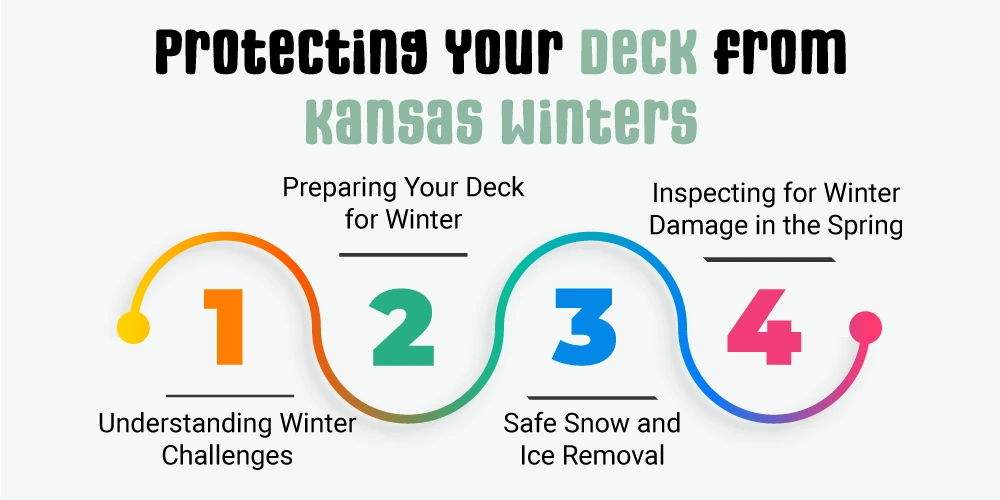
1. Understanding Winter Challenges
Kansas winters bring snow, ice, and fluctuating temperatures, which can cause materials to expand and contract. This freeze-thaw cycle can lead to cracks, warping, and structural damage over time if not properly addressed.
2.Preparing Your Deck for Winter
Before the first snow, clear your deck of any furniture, planters, or other items that can trap moisture. Clean the surface to remove debris and stains that could lead to mold growth. Consider applying a protective sealant to wood decks to shield them from moisture absorption.
3.Safe Snow and Ice Removal
When snow or ice accumulates, use a plastic shovel or a broom to gently remove it. Avoid using metal shovels or harsh chemicals like rock salt, as they can damage the decking material. Instead, use sand or non-corrosive ice melt products to help with traction.
4.Inspecting for Winter Damage in the Spring
After the winter months, give your deck a thorough inspection. Look for signs of warping, cracking, or damage caused by the freeze-thaw cycle. Early detection can prevent larger repairs down the road, ensuring your deck stays in great condition for years to come.
Deck Repairs: Common Issues and Costs
Over time, your deck may experience wear and tear, especially in areas like Overland Park where weather conditions can be tough on outdoor structures. Identifying and addressing repair needs early can prevent more costly fixes down the road.
Signs of Deck Damage
- Rotting Boards: Look for soft, spongy spots or discoloration. This often indicates water damage or mold, which can weaken the structure of the deck.
- Loose or Wobbly Railings: If the railings feel loose or unstable, it could mean the posts are no longer securely anchored, posing a safety hazard.
- Unstable Support Posts: Leaning or shifting posts can compromise the deck’s structural integrity, making it dangerous.
- Cracked or Splitting Wood: Visible cracks or splits in the decking material are signs of wear from moisture or temperature fluctuations, weakening the boards.
- Warped Decking: Uneven swelling or shrinking of wood boards is a sign of moisture damage, causing the deck to lose its original shape and stability.
Understanding Deck Repair Costs
Deck Repair costs vary depending on the type of damage and the material of your deck. Here’s a breakdown of typical repair costs for decks in the Overland Park area:
Repair Type | Description | Estimated Cost Range |
Board Replacement | Replacing a few damaged deck boards | $100 – $300 per board |
Railing Repair | Fixing loose or damaged railing sections | $300 – $800 |
Post Repair/Replacement | Repairing or replacing a single support post | $400 – $1,000+ |
Cleaning & Sealing | Pressure washing and applying sealant or stain | $500 – $1,500+ (depending on size) |
Stair Repair | Fixing loose or wobbly deck stairs | $200 – $600+ |
Note: These are rough estimates, and costs may vary based on deck size, materials, and complexity. It’s important to get an accurate quote from a local contractor.
Hiring a Deck Contractor in Overland Park
Choosing the right deck contractor for your project is crucial to ensuring quality work and a smooth construction process. A reliable contractor not only helps in bringing your vision to life but also ensures that the deck meets local codes, safety standards, and durability expectations. When hiring a contractor, it’s important to consider their experience, reliability, and approach to customer satisfaction. It’s recommended to check their credentials thoroughly and gather as much information as possible before making your decision.
- Experience & Expertise: Look for contractors with experience in deck building and repairs, especially those familiar with Kansas weather conditions and local styles.
- Licenses & Insurance: Ensure the contractor is licensed and carries the necessary insurance to protect against accidents or damage during the project.
- References & Reputation: Always ask for references from past clients and check online reviews to gauge their reliability and the quality of their work.
- Multiple Quotes: Getting at least three quotes allows you to compare pricing, services offered, and the contractor’s approach to your project.
Questions to Ask: Ask about the contractor’s project timeline, handling unexpected issues, warranty for the work, and their process for ensuring the deck’s long-term durability.
Frequently Asked Questions (FAQ)
How long does a deck typically last in the Overland Park climate?
The lifespan of a deck in Overland Park varies based on the material. Pressure-treated pine decks typically last 10-15 years with proper care, while composite or PVC decks can last 25-30 years or more. Regular maintenance, such as cleaning and sealing, is essential to extend the life of your deck, regardless of the material.
Do I need a permit to build or repair a deck in Overland Park?
Yes, building or repairing a deck in Overland Park typically requires a permit. It’s important to check with the city’s planning or building department for the most up-to-date permit requirements before beginning any work. Failure to obtain the necessary permits could lead to fines or delays.
What's the main difference between composite and PVC decking?
Composite decking is made from a blend of recycled plastic and wood fibers, offering a wood-like appearance with minimal maintenance. PVC decking, made entirely of plastic, is more resistant to moisture, insects, and fading. While PVC decking tends to be more expensive, it offers superior durability, especially in areas with extreme weather conditions.
How often should I clean my deck?
It’s recommended to clean your deck at least once or twice a year, usually in spring and fall. Regular cleaning helps remove dirt, leaves, pollen, and prevents the growth of mold and mildew, which can be common in Overland Park’s humid summers. This also helps maintain the deck’s appearance and longevity.
What are the signs my deck needs professional repair or replacement?
Key signs that your deck may need professional attention include wood rot, large cracks or splits in the boards, loose or wobbly railings, unstable posts, or excessive sagging. If you notice these issues, it’s best to contact a professional for an assessment and avoid further damage to your deck’s structure.
Final Thoughts!
When planning, building, or maintaining a deck in Overland Park, it’s important to understand your specific needs, the local climate, and the materials that best fit your space. Regular upkeep and timely repairs can significantly extend the life of your deck, ensuring that it remains a valuable addition to your home. A well-constructed and maintained deck not only enhances your outdoor living experience but also increases your home’s value. By investing in quality materials and proper care, you’ll enjoy years of relaxation and entertainment in your ideal outdoor space. Ready to get started with your deck project or need expert advice on deck repairs and maintenance? Reach out to Aaron’s Painting & Remodeling for professional guidance and tailored services for Overland Park homeowners.
